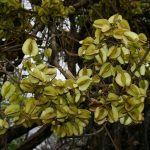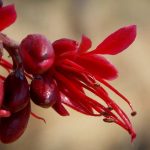TREE LIFE
May 1998
The annual subs ($60) are now due. If you haven’t already paid, please use the invoice attached to your February Tree Life and indicate if your address has changed.
Stop Press! Anthon Ellert, Chairman of the Bulawayo Branch is planning a trip to the botanically exciting Buchwa Mountain and Nyoni Hills in August. This entails advance planning so if you think you would like to be on that trip please contact Anthon in Bulawayo at home on 46586 or during office hours on 540581 as soon as possible so that an assessment of the size of the group can be made and plans set in motion.
MASHONALAND CALENDAR
Saturday 2nd May. Botanic Garden Walk. N.B. Note changes to wintertime again. This month Tom continues the series on some of the lowveld trees. We will meet Tom in the car park at 10.45 for 11 a.m. – there will be a guard for the cars.
Sunday 17th May. After the A.G.M. we will walk in the lovely Botanic Garden Extension at Christon Bank. The A.G.M. this year will be something of an experiment, as we will not have a ‘host or hostess’. The meeting will take place on a flat area under some really beautiful Brachystegia glaucescens to set the mood.
As there are no facilities please bring your chair, tea and a cake or other eats to share.
Saturday 23rd May. Please phone Mark Hyde for this month’s venue and time.
Saturday 6th June. Botanic Garden Walk.
MATABELELAND CALENDAR
Sunday 3rd May. A morning only outing (or bring a picnic lunch if preferred) to Mabukuwene to look at 2 or 3 species. The walk will be led by Tessa Ball followed by a brief AGM. Meet at Girls’ College at 8 for 8.30 a.m.
Wednesday 6th May. The next episode of The Private Life of Plants at Girls’ College at 7.30 for 8 p.m. Please use the Pauling Road entrance where the security guard will admit your car.
Sunday 7th June. All day visit to the Matopos. This outing is not to be missed.
DICK PETHERAM
I first met Dick Petheram, (in the administrative sense) in 1966. I had just started work in the Bulawayo office of a government department. In my ‘In Tray’ that first day was a memo to all staff. Briefly it admonished us all to make sure that when we collectively built buildings on government land, we must preserve as many indigenous trees as possible, signed R. W. Petheram.
Dick was then I think Director of Works (I am far away from a proper database, so apologies if I am weak on some facts), I had some misgivings about my new appointment, but when I read Dick’s memo I knew right away here was my kind of person.
A few years went by before I first met Dick and Edone in person, Tree Society outings in Mashonaland, and the privilege of knowing them both has never faded.
Dick was by this time retired, but typically he still drove things dynamo fashion. From soon after that first meeting and for nearly a decade, I was involved in grassroots conservation work with Dick. The Conservation Trust was under formation, and early on it chose the Makabusi Project as a ‘flagship’ enterprise.
Dick was chairman of the Makabusi Steering Committee. So many of us worked at it but I say without any hesitation, Dick stands first among a small legion of unsung heroes, without whom we would not have the Mukuvisi Woodland as it is today.
There is so much to say, but one anecdote must be told: Rhodes & Founders weekend 1976. Dick had said to me “Let’s update Doug Aylen’s checklist for the Woodland”. So on the Saturday, we started at 8 a.m. and apart from a couple of coffee breaks we walked the Woodland until 4 p.m. Remember Dick already had an artificial hip at that time. Dick looked still as fresh as a daisy; I was on my knees…
So many memories!
Dear Edone and family, our thoughts go out to you. It was one of the greatest privileges of my life to claim Dick as a friend, and hackneyed though it may sound, I am confident that if ever I am considered good enough to go to that place where Dick has gone, I will find a note in my ‘In Tray’, “Next Saturday, 0800, I will start to show you the vegetation”.
George Hall. U.K.
CHAIRMAN’S REPORT 1997-1998
Despite 1997 having passed so quickly, I’m glad to say that the Society kept up its pace of activities and hopefully met the aspirations of our members.
It is with sadness that we record the passing of Dick Petheram, former Chairman, trustee and a pillar of the society who slipped away in mid February. Dick set the pace for many years and his area of special interest was the Binga swamp forest in the Arcturus area. Geoff Archer, a long time member of the society who shared his incredible knowledge with all of us especially that of the Matopos passed away in January. Geoff and Dick built a great foundation in their respective sides of the country for the Tree Society and for conservation in general and my condolences go to the families.After the last Annual General Meeting a group of interested members met to form a group whose sole purpose would be the writing of articles of a’ botanical’ nature for inclusion in locally produced magazines and newspapers. Initially some interest was received but lately it appears that pre-edited articles from overseas authors have become the standard giving the impression that the local media is disinterested.
The Botanic Garden Fence Fund, to which members contributed in 1996/7, is invested awaiting the result of the tender, which will result ‘hopefully’ in some action in the near future. This project has suffered from many delays so we can only hope that the final result will be a success as the Botanic Gardens committee has put considerable effort into this project.
Without our stalwart supporters the society could not operate as it does. Our Botanic Garden walks continue thanks to Tom Muller. Thank you Tom for your time and patience. Mark too provides us with a tremendous fund of knowledge and inputs considerable time for his Saturday afternoon Botanic interest walks, Mark most grateful thanks. A number of semi-decomposed specimens have found their way to Bob Drummond over the past months and thank you for naming them for us. Maureen deserves special thanks for as editor of Tree Life, secretary and fitting in the mapping of field cards is an onerous task and we all benefit so much from her dedication.
Before highlighting our monthly outings grateful thanks to Phil Haxen for leading most of our walks and to our hosts who always make us so welcome. Possibly one of the most exciting trips this year was made by Bulawayo to Sentinel Ranch in January where several new plant species were recorded. Unfortunately a prior arrangement had been made by Harare to revisit the Eastern Districts and so we were unable to go.
Other exciting venues over the year included a trip to the foothills of Ngomakurira for Harare and the dam site at How Mine with Olea europaea for Bulawayo, a surprise for Anthon at Luveve where some white flowering Aloe excelsa were found and Harare went visiting the botanically taxing Vumba area. Mutterings were noted in Tree Life about the plumbing at Gwaai Valley Safaris yet it seemed to have been a most worthwhile and interesting place to see especially as the planned Gwaai-Shangani Dam will flood a large portion of the valley. Back to Harare with a visit to the bird sanctuary at Lake Chivero for November and the Christmas social at Serui Source.
January provided an opportunity to visit the Cottrill’s once again and February tested our knowledge of the subspecies of Pterocarpus rotundifolius, while Bulawayo recover¬ed from the Sentinel trip by watching the video of the Private life of Plants. The Wilsons in the Pote valley took us to another delightful spot in March and Chipangali proved a venue for Bulawayo to assist in establishing an indigenous woodlot.
As membership of the society is so widespread Tree Life remains the contact and many members have expressed how much they enjoy it. My thanks for contributions from Mark, Lyn Mullin with his fascinating articles about Livingstone’s Zambezi expedition, Mary Toet for the entomology, and it is pleasing to read an article from Dickie Greaves once again. Further thanks to the numerous other members who send in such interesting articles.
The committee remains as it was last year and my thanks to the members for the excellent job they do.
Once again I hope you have found our outings to be interesting and enjoyable.
-Andy MacNaughtan
OUTING TO BURNSIDE – 15 MARCH 1998.
Frank and Pam Wilson’s Burnside Farm, located in the picturesque Pote Valley, was the venue for some 35 members, many from the Bindura area itself. Frank and Pam had gone to a lot of trouble to make the day a success. After tea and sandwiches on the lawn in the delightful homestead garden, the group set off along a farm road, specially graded, making for a low granite dwala. The parking area recently mown, Frank had provided a security presence as a precaution in what appeared to be a perfectly tranquil spot. Farmers are not exempt from the prevailing lawlessness, it seems, but our day remained unspoiled and peaceful.
Ably led by Andy, the Society Chairman, we first saw at the foot of the dwala a fine specimen of Strychnos spinosa and close by up the slope was Bauhinia petersiana with its hooked tendrils enabling it to climb over other plants to a degree. Flanking the open granite slope was fragmented rock and a gravelly sandy soil in which the vegetation had secured itself. It quickly became apparent that this dwala site and its vegetation was very similar to one we had visited six months earlier on Ivordale Farm on the Mutoko road about 25km away to the south, bringing home the point how consistent the relationship between vegetation and soil type remains within a given climatic zone if undisturbed by Man. To name a few of the tree species common to both sites –
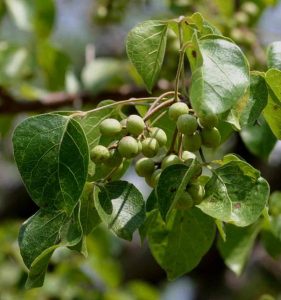
Commiphora mossambicensis. Photo: B.T. Wursten. Source: Flora of Zimbabwe
Commiphora mossambicensis, Sterculia quinqueloba, Pseudolachnostylis maprouneifolia, Afzelia quanzensis, Julbernardia globiflora, Ozoroa insignis, Lannea discolor, Cussonia arborea, Pterocarpus angolensis. At both sites the trees were generally stunted, as one would expect on such a shallow and sandy soil. However, on the Ivordale dwala Euphorbia matabelensis was prolific and Combretum apiculatum was common suggesting that in fact Ivordale was the drier of the two sites.
A few shallow trenches in the broken rock proved that prospectors had examined the site in the long past, but at present there was little interference apart from minor collection of bark or roots for ‘muti’.
Descending to the westerly foot of the dwala, the vegetation was better watered by shedding from the rock above. The soil was more of a loamy sand and deeper and so able to hold more of the incident water to the benefit of the vegetation. Strong specimens of Ziziphus mucronata, Combretum hereroense, Combretum adenogonium, Combretum collinum, and Terminalia stenostachya were present with Flueggea virosa in the understorey. Moving further down the gradual slope, the vegetation soon changed to semi vlei on soil with a much greater clay content, Ficus sycomorus, Ficus thonningii; Piliostigma thonningii, Acacia goetzei were seen with strong specimens of Dalbergia melanoxylon together with Crossopteryx febrifuga.
Soon someone called out that there was an attractive specimen of Ginan tonicii waiting to be appreciated back at the car park, which was the signal for the picnic lunch break!
We moved further into the semi vlei land in the afternoon. Strongly grassed and open with woodland copses limited to the slightly raised better-drained spots, the area was clearly a valuable sponge in the local drainage system. The interface between the woodland and the grassland was generally well defined. Frank confirmed that fire had been largely excluded for at least 10 years, which accounted for the presence of Acacia polyacantha and Brachystegia boehmii in the fringe zone between woodland and grassland. The former were quite large specimens with their faster growth rate while the latter were as yet only up to shoulder height and had been browsed it seemed. Other species here included Gardenia ternifolia, Ximenia americana (hairless leaves), Ximenia caffra (hairy leaves), Erythrina abyssinica, Diospyros kirkii (pink midribs) and Lippia javanica (ubiquitous, who can resist pinching a few leaves and buds for that pungent, but n ot unpleasant aroma?). The odd specimen of
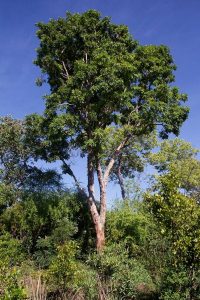
Pericopsis angolensis. Photo: Petra Ballings. Source: Flora of Zimbabwe.
Pericopsis angolensis was also present. I suspect that it might have been more common in that locality but had been exploited in earlier years in constructional work on the farm.
Ecologically, the area was characterised by soil types varying from the shallow and gravelly sands on the hilltop to heavy black clay in the vlei bottom, all derived from the weathering of the same granite parent material. This phenomenon, well understood by pedologists, is a function of the water and drainage conditions present. On weathering, granite rock produces mainly quartz grains and clay particles. Where the drainage is free, much of the clay is carried away leaving a sandy soil. However, where the drainage is impeded the clay accumulates giving a typical vlei soil. The amount of clay and its nature has a significant effect on the water holding capacity and overall fertility of the soil, and so is a major determinant of the vegetation growing naturally on it. Most of our tree species prefer well-drained land even if it is no more than a foothold on a steep hillside but generally the best tree growth occurs on deep well drained soil. The periodic water-logging of vlei soils, whilst very suitable for many grasses, is not suitable for most tree species, additional hazards being the fierce fires and frosts, both common phenomena in vleis.
Pedologists have used this type of ecological association between natural tree communities and underlying soil in their survey work. Armed with aerial photographs they do some ground checks to establish the soil-vegetation relationships, and then, able to recognise vegetation types from the photographs, they can map soil types confidently and accurately even in relatively inaccessible country as long as they have the odd ground check. Much of Zimbabwe has been successfully mapped this way, which can only be done while the woodland remains close to its natural state. Pedologists and geologists become knowledgeable tree people and ecologists in an applied sense. Derek Henderson, a keen member of the Tree Society and regular attendee of outings, is a case in point.
Our thanks go to our hosts, Frank and Pam Wilson, and those who organised the outing, for an interesting and fulfilling day. For my wife and I, the day provided a further reward in the form of a notice from the Prehistory Society pinned to a tree in Pam’s garden of a forthcoming lecture on how local geology affected the siting of Greater Zimbabwe. The lecture proved most worthwhile.
-JOHN WILSON
MATABELELAND BRANCH OUTING – 5 APRIL 1998.
As its specific name implies, Erythrophysa transvaalensis is not endemic to Zimbabwe. It has been found in only three places within our borders. One of these places is Double Cross Ranch, some miles south of Gwanda, where it was seen in the early 1970s. In those days Edna Banks who was not, to my knowledge, a member of the Tree Society, but who supported enthusiastically the local branch of the Aloe Society owned the farm.
Upon Edna’s death the Double Cross Ranch passed into other hands, and it is now my pleasure to be able to thank Mr. Jethro Siziba for allowing the Matabeleland branch of the Tree Society to search for this aforementioned tree on his property.
The Chairman was able to research the subject prior to our visit and the cattle herdsmen reported that they had not encountered a tree of this description in the course of their duties. Hence it was considered that it might occur on one of the many rocky outcrops that adorn the ranch.
We drove through the town and down the scarp that plunges one abruptly into lower altitude. As we turned off on a side road we passed what appeared to be a gold mine, on the hillside above Antenior siding on the railway. There was an extensive dump, although the mine did not seem to be working. The headgear seemed rusty, but there were apparently recent deposits on the dump. These comprise much coarser material, placed over the original fine deposits. The current slump in the price of gold may have necessitated the re-processing of previously mined material. Certainly the slimes dam seemed intact and “managed”. The hills surrounding the mine were heavily wooded with very large and well-developed trees.
The gravel road was in very reasonable condition and very soon we were driving through forest-like countryside.
There were extensive groves of Julbernardia globiflora, tall, well-grown and bearing many seedpods above the canopies. Jonathan observed that these trees generally follow the drainage lines. The soil had changed abruptly to granite sandveld. There were some open patches of Mopane where the trees also stood high. Where there was grass cover it was excellent, and some cattle we encountered were in very good condition.
Sometimes the road ran through Acacia fleckii and sometimes through
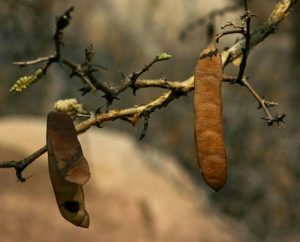
Acacia erubescens. Photo: B.T. Wursten
Acacia erubescens, and sometimes through both species. I was able to learn how to distinguish between these two similar trees. There were also considerable quantities of Acacia galpinii. What a pleasure it was to see no signs of human depredation!
Eventually we arrived at our prearranged destination. There were two pens containing goats and sheep in good condition. A herdsman received us and confirmed our permitted presence. Then we returned some way along the road we had travelled first, to a shady spot in a prime forest, not seen very often in Zimbabwe.
I elected to stay near the car while the others climbed the nearby kopjies to search for our quarry.
Although I wandered no further than a dozen yards’ radius away, I easily found forty trees I thought I knew. I noted these and took samples of some I didn’t know, and others, which I thought, should be confirmed by the oracles when they returned for lunch.
I saw only Go-away-birds, but heard the rhythmic boring of either a Woodpecker or a Barbet. Although I endeavoured to locate this excavator, it eluded me. A little distance in the opposite direction I could hear the shrill calls of a flock of Grey-billed Hornbills. Still invisible, a Tit Babbler sang its pretty descending scale song, as it fluttered above busily.
On one side of the road the undergrowth was really thick and almost impenetrable, but the crowns of the trees were readily identifiable. On the other kopjie side the forest was far more open, and was a habitat for beautiful butterflies. These included a Foxy Charaxes, a Green-banded Swallowtail, a Citrus Swallowtail, a Zebra White and several of those fascinating butterflies that change their appearance according to the season. These were Sulphur Orange Tips in their summer plumage. All except the Charaxes showed interest in a small shrub that may have been a Cadaba. (Not termitaria). There were no flowers visible on this, so l was unable to determine what the attraction was. The insects alighted on the leaves where they sat for a few minutes before changing leaves. These leaves showed no obvious exudation.
The search for our tree was unsuccessful. Both Jonathan and Anthon had reached about half way up a 300-foot cliff, where enormous
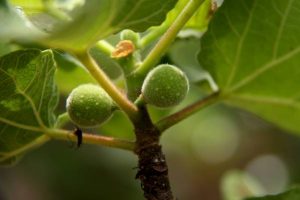
Ficus tettensis. Photo: Petra Ballings. Source: Flora of Zimbabwe
Ficus tettensis were in the process of splitting the edifice apart.
On the return journey we stopped at a couple of open spaces in the Mopane woods. One boasted a small dam where Jonathan collected some pond weed and where Anthon showed me two Maerua species growing together – Maerua angolensis and Maerua parvifolia. I heard, but did not see some parrots, possible Meyer’s.
The second space in the Mopane woods was intensely interesting. Jonathan discovered a “Macimbi processing place”. The ground was covered densely with the faeces of these delicacies, around all the trees. In the open was the charcoal residue where they had been cooked some of the Mopane trees were completely defoliated.
I am informed expertly that the correct procedure to gather Mopane worms should be to wait until they are ready to pupate and descend to the ground to do so, when they can be harvested. But frequently greed compels certain individuals to strip them off the trees, thus preventing the larvae from maturing and frequently causing damage to the trees. Once gathered, the insides of the worms are squeezed out, as they are bitter and inedible. The empty skins are cooked in charcoal embers then spread to dry. Unless a local feast is embarked upon, the worms are packed into bags, which are transported to market. It would appear from investigations carried out in Bulawayo that unscrupulous middlemen are paying as little as $5 for a 50 kg sack of amacimbi and selling them elsewhere for as much as $5 for a 300 g tin!
On the side of the road past the macimbi grew a plant I found completely enchanting. Heteromorpha trifoliata nodded its elegant green buds delicately in the breeze.
This is an area that MUST be revisited, to pursue the quest for the elusive E. T. and for its own sake.
On the way back to town we stopped by an isolated singularly splendid specimen of Brachystegia glaucescens x Brachystegia spiciformis.
It stands at the crest of a rise, majestically mighty in its immensity. This tree bears a little plaque, now illegible, that identifies it as “Mort’s Tree”. Mort was a telephone engineer. If one takes the time to examine the nearby telephone lines, it can be observed clearly that they deviate quite considerably, so that the tree was not felled when the line was first erected. I hope its shadow will never diminish and that Mort’s memory is perpetuated.
-Norma Hughes.
MODERATION AND EXCESS
The plant kingdom is full of superlatives and diminutives. The biggest single living thing on Earth, for example, is a plant. Named after the USA soldier General William T. Sherman, it is a Californian redwood or giant sequoia, with a girth of 24m, a height of 79m and an estimated weight of about 2000 tons. This enormous tree and others of the species, some smaller in girth but greater in height, are found in the temperate rainforests along the northwest coast of North America, notably in an impressive redwood grove in the Redwood Creek Valley in California. Among them is the ‘Howard Libby’ tree – a 112m redwood giant – and there used to be others, known to have reached heights of 120m or more.
In this coastal strip, known as the ‘fog belt’, to the west of the Rocky Mountains, conditions encourage trees to grow to a giant size. Onshore winds bring an abundance of water from the vast Pacific Ocean, and the deep, well-aerated soils are rich in all kinds of nutrients. Another product of this fertile land is the Douglas fir, which pushes its straight, cylindrical trunk over 100m into the sky.
In the wet forests of eastern Australia, some species of eucalyptus grow to comparably monster proportions. The mountain ash, as it is known locally in the state of Victoria, grows up to 100m high, which makes it the world’s largest flowering plant. The tallest one on record was the 114m ‘Thorpdale’ tree in Victoria, which was measured by a surveyor in 1880 just before it was cut down. The tallest hardwood still living today is a mountain ash in Styx Valley near Maydena, Tasmania, which measures 98m.
These New World and antipodean giants contrast markedly with plants growing in impoverished or harsh environments such as polar or hot desert regions. The tiny Arctic willow is a species of tree that stands just a few inches tall on the frozen Arctic tundra. At the other end of the world, Antarctic lichens measure barely 10cm in diameter – even thought some are probably more than 10 000 years old.
Indeed, some of the oldest inhabitants of our planet seem to grow in the most inhospitable places. The gnarled, twisted and slow-growing bristle-cone pines of the deserts and mountains of Arizona and Nevada are thought to reach ages of 4600 or more years old, while the doughnut-shaped creosote bushes of the Mojave Desert in southern California are 10000-12000 years old.
The prize for largest flower goes to the Rafflesia of South East Asia with a diameter of 90cm. The plant is parasitic on vines and has thick, fleshy, five-lobed flowers that weigh about 11kg. At the other end of the scale is one of the smallest flowers on Earth: the blossom of Pilea microphyla, measuring little more than 0.25mm across. It is widespread in the tropics and known as the artillery or pistil plant because of the explosive discharge of pollen from the anthers of the male flowers.
The biggest leaves belong to the giant water lily of tropical South America. The leaves, with upturned edges and a diameter of more than 2m, resemble huge pans. They float on the surface of the water and have thick ribs on the underside, making them strong enough to bear the weight of a child.
The Banyan tree of India holds aloft the broadest crown. Numerous prop roots drop from the branches to increase the tree’s ability to take up water and minerals and these structures develop into secondary trunks. One specimen, with a crown measuring 600m in circumference was thought to be able to shelter 20 000 people.
The African Baobab tree and the Mexican swamp cypress hold the records for greatest girth. The Baobab has a barrel-shaped trunk that may reach 30m in diameter. It is an adaptation to arid conditions, for the trunk stores water. Some enterprising people have excavated Baobab to make homes. The largest known swamp cypress in El Gigante (‘The Giant) in the Mexican village of Santa Maria del Tule. The trunk is not round but has huge buttresses, and if the undulations of its outline are followed, the base’s circumference is 46m. The great Spanish conquistador Hernan Cortez spotted it in the 1520’s and described it in his travel diaries. For many years people claimed that El Gigante had the thickest trunk of any tree in the world, until it was discovered that its size was the result of three trees having grown and fused together.
DEFENCE TACTICS IN DELAYED-ACTION BOMBS
Sterility and malformation take long-term toll on rash predators.
Thorns, toxic substances, nauseating smells – all are instant deterrents. And for the most part they are effective, even if some stubborn browsers die when the warning signals fail. Some plants, however, use less short-term methods, and practise forms of biological warfare that may exterminate or reduce entire populations.
Ageratum houstonianum, a small ornamental plant with blue flowers, does nothing to warn off insects that attack it, but strikes back against future generations. When the insects eat it, they absorb a chemical that acts on the juvenile hormone and causes the larvae to develop prematurely into sterile adults.
Azadirachta indica, the Indian lilac, a member of the mahogany family (Meliaceae), has fruits that are rich in azadirachtine, a compound causing genetic damage. The larvae of insects consuming it suffer a higher than normal mortality rate or skip certain larval stages to become smaller, sickly adults, sometimes unable to breed.
Insects are not the only targets. Some plants make compounds that mimic the function of the steroid hormone oestrogen in mammals and lower the fertility of animals consuming them.
URTICA: THE STINGING DEFENCE
The stinging nettle, Urtica dioca, was once used to make beer. It is still used to make tea and can be boiled as a vegetable, not unlike spinach in taste and texture. But touch it carelessly and it can be uncomfortably painful – unless you grasp it firmly with the fingers where the skin is tougher.
It protects itself from foragers with hollow hairs containing formic acid and histamines. When an animal or person touches a nettle, the tips of the hairs break oft to leave jagged tips – like deadly hypodermics. These scratch the surface of the skin and inject the painful fluid.
Some browsing animals with tender mouths and nostrils are rebuffed, but a lot of cattle have developed immunity to stinging nettles.
These extracts are taken from Nature’s Masterpieces – Published by Readers’ Digest and is acknowledged with thanks.
ANDY MACNAUGHTAN CHAIRMAN


